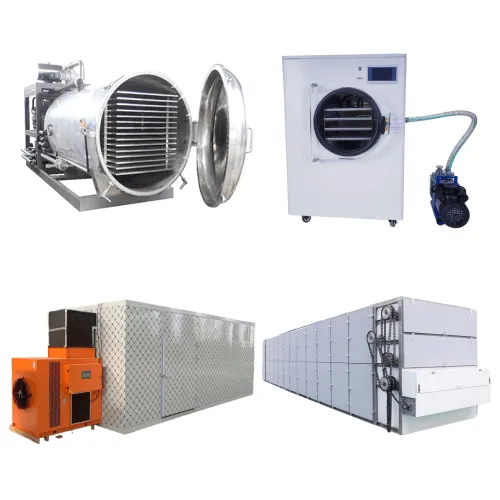Definition and Use Cases of Commercial Dehydrators
Commercial dehydrators are medium-scale drying machines designed for businesses like restaurants, farms, or small food processors to preserve ingredients with consistent quality.
These dehydration technology solutions address a critical gap for small-scale operators by offering capabilities between home appliances and industrial dehydrators. With a typical capacity of 10-50 pounds per batch, they provide reliable performance without the need for massive infrastructure—making them ideal for growing businesses.
Here’s what sets commercial dehydrators apart in real-world applications:
- Scale: Process significantly more than home models (e.g., 20 trays vs. 5 trays) while remaining compact enough for commercial kitchens or small production facilities.
- Common applications:
- Restaurants preserving herbs, fruits, or vegetables for menu items
- Small farms extending the shelf life of seasonal produce
- Artisan food producers crafting jerky, dried snacks, or specialty ingredients
- Key features:
- Durable stainless steel construction
- Precise temperature control (95°F-165°F / 35°C-74°C) for optimal drying
- Energy-efficient operation (1-2 kW per cycle)
For example, a bakery might dehydrate 15 pounds of apples overnight for pastries, while a farm could process 30 pounds of tomatoes daily for value-added products. Many businesses find these machines pay for themselves within 6-12 months by reducing food waste and creating shelf-stable ingredients.
While industrial dehydrators dominate large-scale production, commercial models strike the perfect balance of capacity and affordability for small to mid-sized operations. Next, we’ll explore the key differences between commercial and industrial dehydrators for factories and high-volume processing.
Definition and Functions of Industrial Dehydrators
Industrial dehydrators are heavy-duty machines engineered for large-scale moisture removal across manufacturing sectors. These systems excel at processing bulk materials—from food and pharmaceuticals to chemicals—with unmatched efficiency and automation capabilities.
These industrial workhorses address a core production need: removing moisture from raw materials at scale without compromising quality. Unlike commercial dehydrators designed for small batches, industrial-grade systems process metric tons per cycle with precision controls tailored for continuous operation.
Here’s what sets industrial dehydrators apart:
- Scale: Designed for high-throughput production, with food-processing models handling 500kg/hour or more
- Automation: Equipped with programmable logic controllers (PLCs) for real-time adjustments to temperature, airflow, and cycle duration
- Durability: Built with industrial-grade stainless steel to endure 24/7 operation in demanding environments
- Specialization: Custom configurations available, including explosion-proof models for chemical dehydration
Key applications highlight their versatility:
- Food processing: Producing shelf-stable ingredients like powdered milk and dried fruits
- Pharmaceuticals: Manufacturing moisture-sensitive medications and vaccines under sterile conditions
- Waste management: Reducing sludge volume in treatment plants through efficient dehydration technology
The performance gap between industrial and commercial dehydrators becomes clear in this comparison:
| Feature | Industrial Dehydrator | Commercial Dehydrator |
|---|---|---|
| Batch Size | 200-1000kg | 5-50kg |
| Drying Time | 2-8 hours (optimized cycles) | 6-24 hours |
| Energy Use | 15-30kW (high-efficiency models) | 0.5-5kW |
Advanced features like heat recovery systems slash energy costs by up to 40% versus traditional methods, while pharmaceutical-grade units integrate HEPA filtration for critical sterile environments.
These capabilities underscore why industrial dehydrators dominate mass production scenarios. Next, we’ll explore how their technical specifications translate to real-world operational advantages.
Technical Differences: Capacity, Power, and Efficiency
While commercial dehydrators excel at handling smaller batches with moderate power, industrial dehydrators are engineered for high-capacity dehydration with advanced efficiency—perfect for large-scale production.
Understanding these key differences in dehydration technology helps determine which equipment suits specific application scenarios. Here’s how commercial and industrial models compare in critical performance areas.
Capacity
- Commercial: Processes 5–20 lbs per batch (e.g., Nesco FD-75A holds 15 lbs). Ideal for restaurants or small farms needing intermittent use.
- Industrial: Designed for 50–500+ lbs per cycle (e.g., Buhler Aeroglide systems). The go-to choice for food processing plants with continuous demand.
Power Consumption
- Commercial: Operates on 110V–220V, consuming 500–1500W. Energy-efficient for smaller operations but limited in output.
- Industrial: Requires 480V three-phase power, drawing 5–30kW. Higher energy use, yet optimized for non-stop production with superior efficiency.
Efficiency & Technology
| Feature | Commercial Dehydrators | Industrial Dehydrators |
|---|---|---|
| Heat Distribution | Basic airflow systems | Precision-controlled zones |
| Drying Time | 6–24 hours | 2–8 hours (with turbo drying) |
| Automation | Manual settings | PLC-controlled with IoT integration |
Industrial dehydrators leverage heat recovery systems (e.g., Atlas Pacific models achieve 30% energy savings) and smart moisture sensors to prevent over-drying. Commercial models prioritize user-friendly designs, like Excalibur’s adjustable trays, for simpler workflows.
Pro Tip: Businesses scaling production can explore hybrid models (e.g., LEM 12-tray), which blend semi-industrial capacity with commercial-grade power requirements.
Curious how these specs impact long-term costs? The next section breaks down ownership expenses across both categories.
Cost and Maintenance Comparison: Commercial vs. Industrial Dehydrators
When evaluating dehydration technology for your business, understanding the key differences between commercial and industrial dehydrators is crucial. The choice often comes down to balancing upfront investment with long-term operational efficiency.
Upfront Investment:
- Commercial dehydrators: $500-$5,000 (ideal for small batch operations)
- Industrial dehydrators: $10,000-$100,000+ (designed for continuous production)
Maintenance Requirements:
Commercial models offer simplicity but require regular attention:
- Monthly deep cleaning
- Annual replacement of belts and motors
- Owner-performed repairs are typically feasible
Industrial units provide durability with specialized care needs:
- Professional servicing every quarter
- High-quality components with 3-5 year lifespans
- Requires certified technicians for maintenance
Energy Efficiency:
Commercial: 1.5-3 kWh per batch
Industrial: 0.8-1.2 kWh per batch (featuring advanced energy recovery systems)
Equipment Longevity:
Commercial: 3-7 years with standard use
Industrial: 10-15 years (premium stainless steel construction)
Your optimal choice depends entirely on application scenarios and production volume. Small bakeries may find commercial dehydrators more budget-friendly, while food processing plants typically achieve greater savings with industrial models over time. Curious how to select the perfect dehydrator for your specific needs? Our next section provides a detailed decision-making guide.
Choosing the Right Dehydrator: Key Considerations
Selecting the perfect dehydrator for your needs involves balancing operation scale, budget, and specific application requirements. Whether you're exploring commercial dehydrators for small-scale production or industrial dehydrators for high-volume output, understanding these key differences will guide your decision.
Here’s a streamlined approach to choosing the right dehydration technology:
-
Scale of Operation
- Commercial dehydrators excel in small to medium batches (10–50 lbs per cycle), making them ideal for restaurants, farms, or artisanal producers.
- Industrial dehydrators handle 100+ lbs per cycle, catering to factories, pharmaceutical plants, or large-scale food processors.
-
Budget & Efficiency
- Commercial models range from $500–$5,000, offering moderate energy use and lower upfront costs.
- Industrial units ($10,000–$50,000+) prioritize long-term efficiency for mass production, justifying the higher investment.
-
Application Scenarios
- Precision control: Industrial dehydrators often feature advanced settings for consistent food texture and quality.
- Space requirements: Commercial units fit compact spaces, while industrial models need dedicated floor areas.
-
Maintenance & Durability
- Commercial dehydrators require weekly cleaning and occasional part replacements.
- Industrial dehydrators demand daily maintenance but are engineered for 24/7 reliability.
| Factor | Commercial Dehydrators | Industrial Dehydrators |
|---|---|---|
| Capacity | 10–50 lbs per cycle | 100+ lbs per cycle |
| Cost | $500–$5,000 | $10,000–$50,000+ |
| Energy Use | Moderate | High (optimized) |
| Best For | Small businesses | Large-scale production |
Quick Decision Guide:
- Estimate your daily output needs.
- Compare upfront costs vs. long-term energy savings.
- Evaluate available space and maintenance resources.
With these insights, you’re ready to assess how commercial and industrial dehydrators perform in real-world applications.



